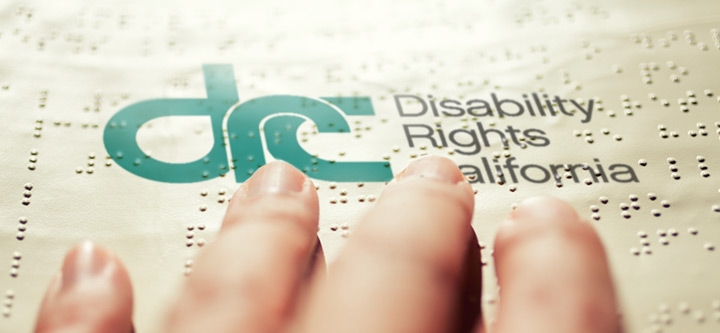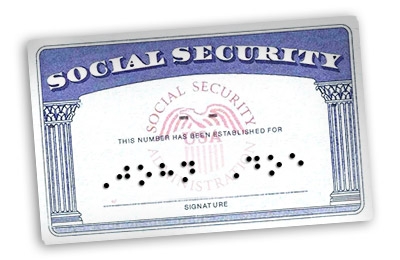Disability Rights California works to ensure equal access to people with physical and sensory disabilities

Disability Rights California works to ensure equal access to people with physical and sensory disabilities

Disability Rights California strives to ensure effective communication for blind and visually impaired individuals. We also work to make sure people with disabilities can access the same products and services as everyone else.
Suit forces California State Lottery to make businesses that sell its products accessible to people with disabilities
Disability Rights California sued the California Lottery in 1998 because it placed its products in businesses that weren't accessible to people with disabilities.
To make their buildings accessible, the California Lottery adopted a Retailer Access Program (RAP) so people with disabilities can access businesses that sell Lottery products. The Americans with Disabilities Act requires that existing buildings become accessible. Prior to the ADA, only new or renovated buildings had to be accessible.
Former DRC attorney Margaret Johnson worked on the case.
The RAP prohibits discrimination when people with disabilities purchase Lottery products. Retailers have to provide reasonable accommodations when needed. Retailers must have clear, unobstructed and accessible pathways of travel to Lottery products and Lottery play centers. They must have accessible parking, sidewalks, aisles, curb ramps, entrances, and counters.
The case was settled. The California Lottery developed regulations implementing the settlement by requiring that all businesses that sell lottery products meet access requirements. The Lottery agreed to survey businesses to ensure compliance with the new regulations.
State Department of Social Services agrees to make materials accessible to blind clients
In 2016, Disability Rights California and Disability Rights Education and Defense Fund (DREDF) reached a Settlement Agreement with the California Department of Social Services (CDSS) and Department of Health Care Services (DHCS) on behalf of three blind individuals regarding accessible materials in the In Home Supportive Services (IHSS) program.
Before the settlement, IHSS program recipients were required to verify the hours worked by their in-home workers by signing paper timesheets. However, recipients like Xiomara Diaz, who is blind, could not read the hours recorded on the paper timesheets by herself or read other printed program information because the state did not provide information in an accessible format for people.
 The agreement required the state to invest in a $10 million system allowing IHSS recipients to approve timesheets independently over the telephone. They can also choose to receive notices and other information in accessible alternative formats of their choice.
The agreement required the state to invest in a $10 million system allowing IHSS recipients to approve timesheets independently over the telephone. They can also choose to receive notices and other information in accessible alternative formats of their choice.
“Before we had this program, I didn’t feel comfortable signing documents I could not read,” Xiomara said. “Now, it’s so much easier to verify timesheets.”
As a result of the settlement, over 111,000 individuals received the accessible information and form of timesheet that they needed to participate in the program.
“We are proud of the commitment and dedication of the three individuals that DREDF and DRC represented, and our collaboration with CDSS and DHCS, which resulted in positive change in the IHSS program,” said Elizabeth Zirker, DRC managing attorney.
DRC filed lawsuit against the Social Security Administration to make its kiosks accessible to blind people
Lisa Marie Irving is a blind recipient of Social Security benefits. She visits her local Social Security Administration (SSA) office to address benefits issues. During a visit to her local SSA office, she found the kiosk machines inaccessible for her to use. She could not locate the keypad connected to the kiosk, and there were no audio instructions telling her what was on the screen. To access the kiosks, individuals are required to enter their social security number and because the kiosk was inaccessible she would have to provide her social security number to another person. Lisa encountered problems making selections on the kiosk. Furthermore, the Braille instructions were located on the side of the kiosk in an awkward position, which made for painful and slow reading.
“I felt left out and dehumanized,” Lisa said. “I also felt an unnecessary and uneasy dependency on the harried security guard,” whom she was compelled to rely on to check her in.
 In 2017, Disability Rights California, Washington Lawyers’ Committee for Civil Rights, and the law firm of Brown Goldstein & Levy filed a lawsuit against the Social Security Administration (SSA) for not making its Visitor Intake Processing touchscreen kiosks accessible to blind people. The case was brought on behalf of the National Federation of the Blind, Lisa and Amy Bonano.
In 2017, Disability Rights California, Washington Lawyers’ Committee for Civil Rights, and the law firm of Brown Goldstein & Levy filed a lawsuit against the Social Security Administration (SSA) for not making its Visitor Intake Processing touchscreen kiosks accessible to blind people. The case was brought on behalf of the National Federation of the Blind, Lisa and Amy Bonano.
“These inaccessible kiosks keep blind individuals from being able to visit SSA offices confidently and independently,” said Autumn Elliott, senior counsel for DRC. “Blind individuals, who are visiting the office regarding their SSA benefits, are instead compelled to share confidential information with strangers or security guards who must help them with the machines.”
In addition, they cannot read the printed ticket generated by the kiosks, which contains their check-in number. They must ask someone else to read the number or risk losing their appointment when their number is called.
The lawsuit alleges that the use of these inaccessible kiosks violates Section 504 of the Rehabilitation Act of 1973. Touchscreen devices like those used by SSA can easily be made accessible. Similar kiosks and automated teller machines (ATM) are already accessible to the blind via methods that include audio output through a headphone jack and input with a tactile keypad.
The lawsuit asks SSA to take the steps necessary to allow blind individuals to check into SSA offices independently, including fixing the inaccessible features of the kiosks, training appropriate staff, and adopting policies governing the use and maintenance of the kiosks. Since the filing of the complaint in 2017, the parties have been engaged in negotiations aimed at resolving these issues.




